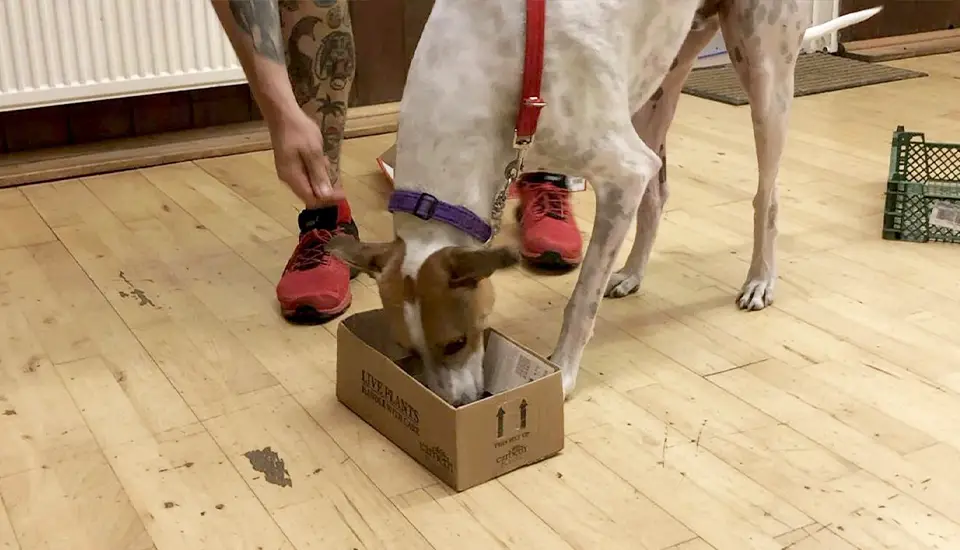Many dogs show certain behaviours that humans consider to be a problem. However, is that strictly true? Is your dog barking, chewing, or digging to try and annoy you, or destroy your things, or is there something more behind their behaviour?
Chances are, the feelings and emotions that lie at the root of your dog’s nuisance behaviours, are frustration, boredom, and anxiety.
The truth is, the vast majority of dogs are expected to fit into our daily lives, and never put a paw wrong. Don’t jump up at guests, don’t steal food from the kitchen top, don’t chew our things, and definitely don’t dig up the garden! However, this set of rules rarely leaves many opportunities for your dog to do ‘normal dog things.’ They spend all their time trying to follow the guidelines we set for them, with little to no downtime to do things they truly desire and enjoy.
Can you imagine how frustrating it would be for you to obey rules that don’t make much logical sense to you, day in, and day out, with no chance to express yourself or unwind?
This is often further fuelled by a dog’s breed traits being misunderstood or ignored. For example, Labradors love to retrieve, Terriers love to dig, Border Collies love to herd and so on. And, these are not just things that these dogs love to do, they are things they need to do. And, if they never have the opportunity to do so in a safely managed way, they will start looking for their own ways to fulfil these intrinsic needs. This is where the problem behaviours creep in!
So, you are left wondering, what can I do to help solve these issues. How can I stop my dog from doing these things? The first step is to steer your mindset away from thinking about how to try and eliminate these behaviours entirely. This is not an ethical option for your dog, and it’s also never going to be successful. Instead, we need to get creative and think of lots of interesting ways we can encourage our dog’s natural behaviours, instead of constantly trying to work against them.
A helpful analogy is a pan of water on the hob. If the heat is turned up higher and higher, the water will reach boiling point. If you force the lid on, the water and steam will bubble out everywhere because it has nowhere else to go. And this is how many of our dogs feel! They have all this energy and all these intense urges to display normal behaviours, without any chances to do so. Their owners are desperately trying to ‘keep them in check’ without realising that what they really need to do is provide them with the opportunity to show the behaviours they are craving!
A great way for us to help our dogs with this, is to utilise enrichment activities to provide them with some much-needed mental stimulation.
A common misconception about the idea of providing outlets for our dog’s behaviour, is that it will encourage the dog to show this behaviour in other areas of their life, which is simply not the case. In reality, the opposite is more likely to be true. Put simply, the more you give your dog outlets for practising natural behaviours, the less likely they will be to default to unwanted behaviours.
Of course, we don’t want our dogs to be raiding the bin, or tearing up our flower beds, so it’s our job to find them more suitable ways for them to express their natural canine behaviours. In fact, this should be a top priority for us as dog guardians.
Here are some of the most commonly reported dog behaviour problems, and how you can use carefully created enrichment activities to help to remedy them:
Digging: Provide your dog with a sandpit, a ball pit, or a specific area of your garden where you actively encourage them to dig.
Chasing: Use flirt poles and encourage your dog to chase them, or play short games of fetch.
Barking: Teach your dog a ‘speak’ and ‘quiet’ cue, so they know when it’s time to be quiet. Some owners also teach their dog a ‘whisper’ cue, where they are allowed to bark quietly!
Chewing: Give your dog suitable things to chew! Long-lasting natural treats and chew toys are great options. Remember to encourage your dog to use them too.
Scavenging: Fill a cardboard box with shredded paper, sprinkle a few treats inside, and encourage your dog to sniff them out. It doesn’t matter if they shred the box in the process, it’s all part of the fun!
Separation Anxiety: Build your dog’s confidence and independence using enrichment puzzles that they have to solve on their own. Start with really easy activities and gradually increase the difficulty and duration.
Stress: Any activity that utilises sniffing, licking, and chewing all work towards reducing your dog’s heart rate, so they are particularly useful for helping them to relax and unwind. Snuffle mats, searching for scattered treats, and lick mats are a few excellent options to try.
Once you start to actively prioritise finding safe and suitable outlets for your dog’s natural behaviours, the relationship you share with them will flourish. Your dog will become happier, and more content, and you will no longer be battling with problem behaviours. Win-win!
What To Do Next?
Get in touch if you would like more information on our daycare services, we allow dogs to do all of these activities leading to a happier healthier dog.

